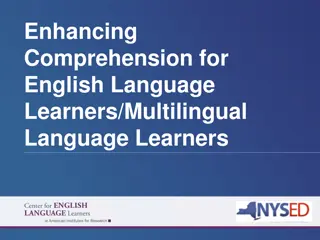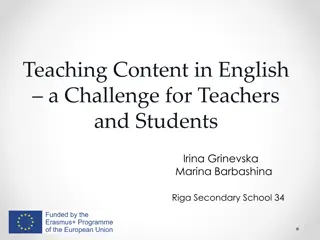Supporting English Second Language Science Learners at University of Limpopo
Developing materials for L2 science learners at University of Limpopo to support previously disadvantaged English second language science learners. The program aims to help students succeed in Maths and Sciences, enabling more black students to enter science-based programs. Focus on improving English proficiency and study skills for academic enhancement in various fields like Natural Sciences, Pharmacy, Optometry, Medical Sciences, and Agriculture.
Download Presentation

Please find below an Image/Link to download the presentation.
The content on the website is provided AS IS for your information and personal use only. It may not be sold, licensed, or shared on other websites without obtaining consent from the author.If you encounter any issues during the download, it is possible that the publisher has removed the file from their server.
You are allowed to download the files provided on this website for personal or commercial use, subject to the condition that they are used lawfully. All files are the property of their respective owners.
The content on the website is provided AS IS for your information and personal use only. It may not be sold, licensed, or shared on other websites without obtaining consent from the author.
E N D
Presentation Transcript
Developing Materials for L2 Science Learners Junia Ngoepe University of Limpopo South Africa
Outline Goal(s) Students Background Teaching Team Curriculum Organisational Matters Course Content Materials
Introduction Previously disadvantaged English second language science learners at University of Limpopo (UL) need support. This can be in the form of specific materials for these students who have shown potential to succeed in Maths and the Sciences.
Programme Goal Bachelor of Science Extended Degree Programme (BSc EDP) as known as UNIFY The long-term goal is to enable more black students to enter a science-based programme to make a good start with degree-level work This will lead to more graduates in the fields of Natural Sciences, Pharmacy, Optometry, Medical Sciences and Agriculture
English & Study Skills (ESS) Goal(s) The proficiency in English should improve students academic and general They should acquire language and study skills which will enhance their academic performance in Mathematics Sciences and the
Students Background They are at the threshold of studying at university Obtained a National Senior Certificate (NSC) qualification Have passed NSC General English (GE) But did not qualify to be admitted into the Science faculty at the University of Limpopo (UL) They have shown potential to succeed in the sciences They are L2 speakers of English
Student Background (Cont.) English is the language of tuition at UL They are taught science in English They have been educationally disadvantaged Had inadequate access to educational services and opportunities to develop their full potential as students in Mathematics and the Natural Sciences Most will be first generation university graduates in their families
Teaching Team Made up of language and content lecturers Local and expatriate staff, at inception Qualified local teachers have taught at NSC level before Locals qualify to teach at University ( M & D levels) Language lecturers have some science background Expatriates experienced in science education matters Locals needed training in science education
Curriculum Biology, Chemistry, Mathematics, Physics & ESS, and Computer Literacy Programme curriculum is interdisciplinary in nature ESS is an intensive pre-study course (i.e. foundation) in an English medium institution Course starts with a diagnostic test There are contact sessions and tutorials & practicals are included e.g. Project
Some Organisational Matters Experienced expatriate staff Accelerated staff development programme for locals Weekly sectional meetings for teaching progress as well as materials development Occasional content interdisciplinary meetings Marks board at end of every term to monitor student progress
Some Organisational Matters ( Cont.) Mainly learner-centred approach BSc EDP sticks to teaching 150 students on average 5 groups of 30 students in each of the 5 core subjects 5 contact periods per group per week ESS compulsory & non-repeat Double-marking practised e.g. Biology and English Woodlice experiment
Course Content ESS focuses on techniques and skills needed by students to become efficient and affective learners These skills include reading and interpretation as well as writing and expression skills The course also covers aspects of grammar which are of particular relevance to scientists or which have been identified as areas of weakness in students writing.
Course Content (Cont.) Emphasis is also placed on the writing of clear, straightforward and grammatically correct sentences, and putting them together to make a cohesive whole ESS also endeavours to encourage both writing and verbalisation of concepts taught in other sections
Materials Materials are potential tools for learning and are supposed to be generators of lively intellectually engaging activities (Pinto da Silva, 1993: 40)
Materials (Cont.) The ultimate objective is that the materials used as well as the tasks performed should replicate what usually takes place beyond the classroom boundaries (Ahellal, 1990: 38)
Materials (Cont.) Lecturers should continually be concerned with asking themselves whether their materials are producing the results they intend to achieve If not, how can they improve or replace them
Materials (Cont.) ESS science materials could be characterised by appropriacy, authenticity and be prepared in-house They are also a combination of internationally and locally produced materials
ESS Materials 5 study notes Reference materials Adapted for cohorts of students
Study Manuals Grammar and Word Classes Module Writing Module 1 Writing Module 2 Readings (Science Readings) Comprehension Passages Listening Comprehension and Mini- lectures booklet
Grammar & Word Classes Module 8 Units: Singular & Plural Form of the Verb The Impersonal Scientific Style The Passive Modality Word Classes
Grammar & Word Classes (Cont.) Countable & Uncountable Nouns Using the Dictionary to Find Meanings Linking Devices General & Specific Sentences Supplementary Exercises
Writing Module 1 5 Units Cause & Effect Quantity & Comparison Relationships Describing Structure, Content & Function The Passive 2
Writing Module 2 2 Units Describing Graphs Note-taking & Note-making
Reading Comprehension Passages 14 Science Readings (include questions/tasks) Energy and related problems in Malawi The motor car and pollution Sick miners pay full price for gold Wake-up call for world s health The rise and rise of Pakistan s people
Reading Comprehension Passages (Cont.) Contraception for elephants a viable option? The world s food Pollution and lung cancer Back to the days of deadly smock Will it get any worse?
Reading Comprehension Passages (Cont.) Less is more Lead blights the future of Africa s children Greenhouse gases and the global warming trend The social costs of excessive alcohol consumption
Listening Comprehension Mini- lectures These lectures are for note-taking practice The lecturer simulates a lecture while students take notes Mini lectures are The Field Trip, Energy, The Noble Gases, The Preservation of Food , etc. Students do pertinent exercises pre- or post mini-lectures attendance
Reference Materials The following reference materials complement study materials The Oxford Paperback Thesaurus Longman Dictionary of Contemporary English Oxford Dictionary of Science Practical Student s Edition English Usage, International
Reference Materials ( Cont.) UNIFY Student Handbook Periodicals such as New Scientist and The Mail and Guardian Websites such as Google , Yahoo , Mamma and Wikipedia
Methodology Students sit for a language of science pre test Materials suitable for identified needs are used for the cohort of students Students sit for a language of science post test after materials were used Performance in the 2 tests compared
Results Students perform significantly better in post test Specific materials be developed for cohorts of disadvantaged English language students in the sciences The number of disadvantaged students who succeed in Maths and the Sciences will increase, in the long term
Conclusion If language and content teaching staff work in concert towards improving second language science learners proficiency, the number of students who succeed in the sciences will increase.
References AHELLAL, M. 1990. Using Authentic Materials in the Classroom: Theoretical Assumptions and Practical Considerations. English Teaching Forum, 28(2): 37-38. HUTCHINSON, T. & WATERS, A. 1987. English for Specific Purposes. Cambridge: Cambridge University Press. JANSEN, J., NTSHINGILA-KHOSA, R. & CRANFIELD, C. 2005. University of the North Mathematics and Science Foundation Year (UNIFY) Phase II. Final (Ex-Post) Evaluation. Unpublished Report. Pretoria: European Union Commission. NGOEPE L. J. 2007. The University of Limpopo Mathematics and Science foundation year course in English and Study Skills: an evaluation. Potchefstroom: North West University (Thesis PhD). PINTO DA SILVA, C.1993. ESP: Back to Methodology. English Teaching Forum, 31(2): 40-41.
Thank you Any Questions? junia.ngoepe@gmail.com























